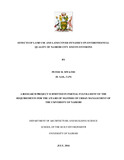| dc.description.abstract | Land use and land cover change is considered one of the major drivers of global change and has significant implications for many international policy issues as well as key element in the current approaches and strategies in environmental management and natural resources. Despite this, the various interactive nature of land change and dynamics is not fully understood, hence the difficulty in developing effective adaptation strategies for urban development. The study sought to establish the effects of land use and land cover dynamics on the environment of Nairobi city and its environs. This was done through examination of land use and land cover schema for the city between the years 1988 to 2010, evaluation of the trend, nature, and rate of land use and land cover dynamics over the years, assessment of Land Consumption Rate and Land Absorption Coefficient for the City and highlighting the environmental implications of the land use and land cover changes. The study utilized satellite images and field study. Primarily satellite imagery was used to classify the land cover of the region. Additionally, a field study was undertaken to confirm and improve mapping accuracies of spatial changes. Landscape observations, meetings with experts and structured interviews were conducted in the study areas. The study established that Nairobi city has, in a period of 12 years (1988-2010), experienced an increase of 438.29% in urban built-up areas and open lands, forest cover decreased by 38% while agricultural and riparian vegetation decreased by 98%. The agricultural and riparian vegetation, rangeland and shrubs and forests have mainly given way to expansion in built up areas and open lands. Deductively, the land use and land cover dynamics of the city are influenced by population growth, income levels, its physical attributes, land availability, land taxation, land accessibility, urban development policies, weak enforcement framework, technology and political power. The study notes that land use and land cover changes have led to various environmental effects, namely land degradation, destruction of habitat, erosion, air and water pollution as well as urban heat island. The major cause of this being institutional weaknesses and proliferation of the informal settlements in the urban periphery. These have impacted significantly on natural resources and habitat quality. The study recommended enhanced development control, Expansion and Maintenance of the Infrastructure, Environmental Impact Assessment, and formulation of up to date and relevant policies as well as embracing a Multi-Sector Partnership Approach to Urban Development. | en_US |



